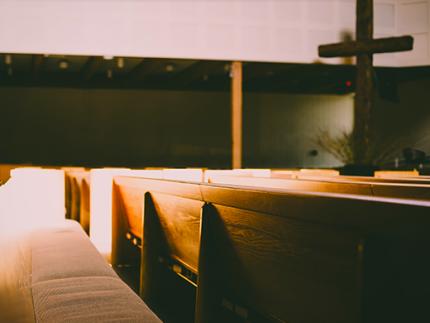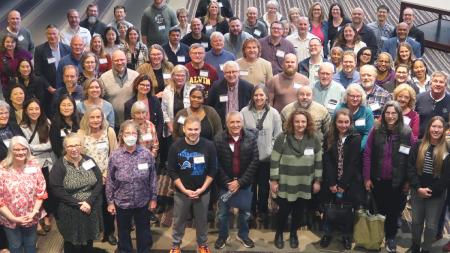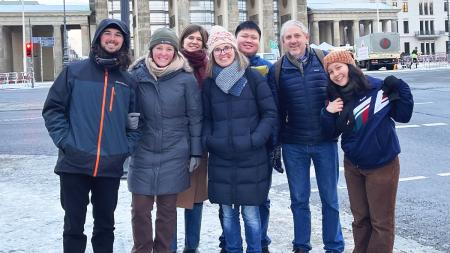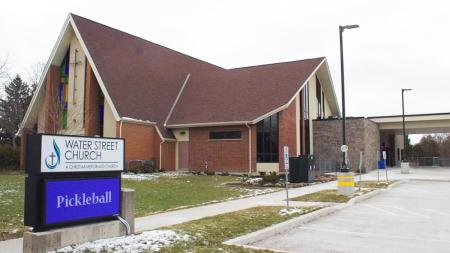Helping Us Find a Way

I stood outside of Coit Community CRC in Grand Rapids, Mich., in the bright sunshine. In a couple of days I would be chairing a church council meeting at which we planned to talk about when — and in what manner — we might return to worship in that still-sturdy, white-painted clapboard structure dating back to the 19th century.
First a home for United Methodists, the building became the meeting place of Coit Community more than 25 years ago. Featuring stained-glass windows and a steep, peaked roof, the church stands on an edge of the “Medical Mile,” a long stretch of hospitals, medical offices, and free-standing medical treatment facilities in downtown Grand Rapids.
The sun beat down on me as traffic zipped by on Lafayette Avenue, where I stood across the street from the church. It struck me just how deeply many of us are connected to the very buildings where we worship, the pews or chairs on which we sit during services, the tables on which we eat potlucks, and the rooms in which we take classes or attend Bible studies. Our gathering places help to define us and can help bring us closer to God and certainly to one another.
But it also reminded me — and especially after watching a webinar hosted by the CRC’s Pastor Church Resources office, COVID Conversations and Your Church Council — that the church is much more than the building in which we gather on Sundays and at other times during the week.
Pastor Jerome Burton, with whom I serve as a commissioned pastor at Coit, has commented that this unprecedented period that has forced confinement and social-distancing on us because of COVID-19 has really pointed out to him that the church is not the walls of a building. It is the people — and the people can meet wherever they are.
Meanwhile, he gave a powerful sermon last Sunday in anticipation of Pentecost, making the point that the church emerged from a place — that upper room — in which the disciples had gathered for 10 days of waiting and prayer after Jesus’ ascension. The Holy Spirit broke in among them there and sent them pouring from the building, on fire for God, speaking the tongues of many nations — and on that same day many were baptized.
Countless churches are struggling right now as they wonder about their identity and their ties to a physical meeting place and where they are used to doing ministry: Do the walls shape us; is it the “upper room” that makes us who we are? Where do we put our treasure — in one place, or is it scattered? Are the sanctuaries where we worship the holiest of holies for us?
Should we make plans to open our church doors, make some modifications, and have faith that God will take care of the rest — or do we wait and watch carefully to see what course this murderous virus takes before we step back into our beloved buildings?
Or do we steer clear and search out other means to be the church — and to be the church not just for now but for months to come — or even longer?
Maybe even the dread virus has begun to change how some of us consider what it means to be practicing Christians in an age of increasing uncertainty.
In the PCR webinar I mentioned, none of the participants had clear or easy ideas on what we should do now that our churches have been closed for the past two months — and as hard questions arise on what to do next. Each person brought years of experience and their own personal struggles to the panel discussion in which they tossed around answers to these questions.
Helping to facilitate the discussion was Sean Baker, former pastor of Creston CRC in Grand Rapids, who now works with PCR. He laid the groundwork of the presentation this way:
“We have wondered if churches are eager to get back to their bread and butter — the Sunday morning, in-person worship service,” he said. “But what I’m hearing is that actually this decision-making process feels more like a minefield. . . .”
Baker has come to see the need — and hence the PCR webinar — for more conversations about this topic. It’s important to fully air the different views, examine all sides, allow emotions and thoughts to flow, and let everyone have their say. There may be no absolutely right or wrong answer here. Pastors, he has come to see, are feeling pulled in all directions — as are family members living under the same roof who attend the same church. They are asking, around their dinner tables, “Do we go, or do we stay home?”
“We think that helping to hold different conversations can be part of our witness right now. . . . We are always working to help equip pastors and church councils to have difficult conversations — and COVID-19 has raised the stakes,” said Baker.
Members of the panel included Rev. Heidi DeJonge, pastor at Westside Fellowship CRC, Kingston, Ont.; Stan Baker, a former school teacher and administrator who has also been a council leader at Hope Fellowship CRC, Courtice, Ont.; Rev. Chris DeVos, a staff person with the Colossian Forum and a member of the Pandemic Response Team at Pillar Church, Holland, Mich.; and Rev. Michael Gulker, president of the Colossian Forum and a member of Calvary CRC, Wyoming, Mich.
In their conversation, the panel talked of their pain at being unable to meet in person with loved ones, for both festive occasions and to grieve hard situations. They talked about being daily aware of the suffering that COVID-19 is causing people in our communities and around the world, and the pressures that pastors are feeling as some people want to return to church on Sundays and others are in no mood to return too soon.
“This virus has made clear the systemic complexity of what we do in church,” said DeVos. “Even the decision of coming back — including how best to use the entryway and cleanse the bathrooms and the nursery — cause uncertainty.”
We have to consider how we will share Bibles, prayer books, and hymnals. Do we sing or not? And, in the process, we must think about how we best keep the people around us healthy, which also means keeping ourselves healthy.
And as we think through this process, we must ask how we can best care for the vulnerable among us. “The virus itself makes us think of our own brokenness and how this situation is very much about life and death,” said DeVos.
DeJonge spoke of tears that flowed a Sunday or so ago when the internet connection that many churches used for Sunday services broke down. That connection to others, however ethereal over the internet, was gone, and DeJonge felt emptiness and sadness, she said. The people in her church community had hoped to gather over the web, and she couldn’t offer what she was hoping to share. They had been looking to her for a hope she couldn’t provide that morning.
Still, the experience helped to remind her of the sheer value that actually meeting together can have. This can happen over the computer screen or in person, but it is about connecting — preferably face-to-face, but screen-to-screen if need be.
“When we gather, God can bring about things that are more helpful and amazing and miraculous than could ever be imagined,” said DeJonge. Switching gears a bit, she added, “We need to be agile and lean into the future. We need to experiment and have conversations about the future and what the roles we play in it will look like.”
Gulker added: “We can be together and let whatever it is we are going to do to flow from that. Keep in mind that we can get things wrong because God forgives.”
As challenging as today’s questions are, as hard as the future seems to be, it’s good to remember we do have a path forward, panel members made clear. We follow Christ, who always leads us through the dark, dangerous paths. In fact, sheltering in place may prove for the church to be an important, if difficult, means to an end.
“We must remember that the church is much more than a human institution. Christ holds us together, not our cleverness,” said DeVos.
That’s a good point; this is a time for a heaping helping of humility. This is a period in which sharing what is on our minds — lovingly, wisely, and yet with courage — can help us sift through how we can best be together again.
Certainly our church buildings draw us: the smells; the way sunlight plays through the windows on a Sunday morning; the firm hug from someone we haven’t seen for a while or from someone we see every week; the way the pastor’s words can help sustain us and how the praise group’s (or choir’s) music interplays with those words of the sermon.
Right now, we’re not there. I stood outside my church and realized how tough our upcoming council meeting will likely be. Standing there, however, I also saw people getting ready at the ROCK, a house the church owns and uses as a food bank. Ministry activity was obvious at the ROCK. But the church building stood quiet.
Where do any of us go from here? A good question — with lots of answers. But some CRCNA ministries, thankfully, are helping us find a way — through posts like this one and the PCR panel discussion. On my end, I plan to use some of the information and resources the CRC is putting out. They are being made available at a crucial time and can feel a bit like a lifesaver.


